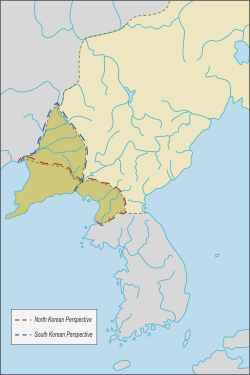This article needs additional citations for verification. (February 2018) |
Little Goguryeo 고려 高麗 | |||||||||||
|---|---|---|---|---|---|---|---|---|---|---|---|
| 699–820 | |||||||||||
 Dark yellow - Little Goguryeo, Light yellow - Balhae | |||||||||||
| Status | Vassal state of Tang dynasty De facto independent kingdom | ||||||||||
| Capital | Unknown | ||||||||||
| Common languages | Goguryeo (Koreanic) Middle Chinese | ||||||||||
| Religion | Buddhism, Confucianism, Taoism, Chinese folk religion, Korean shamanism | ||||||||||
| Government | Monarchy | ||||||||||
| History | |||||||||||
• Establishment | 699 | ||||||||||
• Fall | 820 | ||||||||||
| |||||||||||
| Today part of | China North Korea | ||||||||||
| History of Korea |
|---|
 |
| Timeline |
|
|
| History of Manchuria |
|---|
 |
Little Goguryeo (Korean: 소고구려; Chinese: 小高句麗; alternatively Lesser Goguryeo) is the name of a state thought to have existed on the Liaodong Peninsula, proposed by the Japanese scholar Kaizaburo Hino (ja:日野開三郎). The existence of the state is debated among scholars.[1] The state was mentioned in historical records, with its leaders recorded as Governors-General subject to the Tang dynasty in the documents of the Tang government.[2][3] It was supposedly established by the refugees of Goguryeo after its defeat by the Tang dynasty.[4]
Following Goguryeo's defeat by the Tang–Silla alliance, the Liaodong Peninsula was administered by the Tang dynasty. The theory is that the Tang dynasty eventually lost effective control of the region due to rebellions staged by Goguryeo refugees, and Liaodong became a buffer zone between the Tang dynasty and Balhae (Bohai). Although Lesser Goguryeo declared itself an independent kingdom, it was soon absorbed into Balhae.
- ^ Furuhata, Toru (古畑徹) (1992). "いわゆる「小高句麗國」の存否問題" [The Existence of the so-called "Koguryǒ-Minor Kingdom 小高句麗國"]. 東洋史研究 (The Journal of Oriental Researches). 51 (2): 204–229. doi:10.14989/154403. pdf
- ^ 《册府元龟·外臣部·封册二》:“玄宗先天二年二月拜高丽大首领高定傅为特进”
- ^ 《册府元龟·外臣部·封册二》:“开元三年八月高丽吐浑等诸蕃降附制曰:天亡骄子胡运其终国有忠臣汉封斯在高丽王莫离支高文简都督”
- ^ "소고구려".